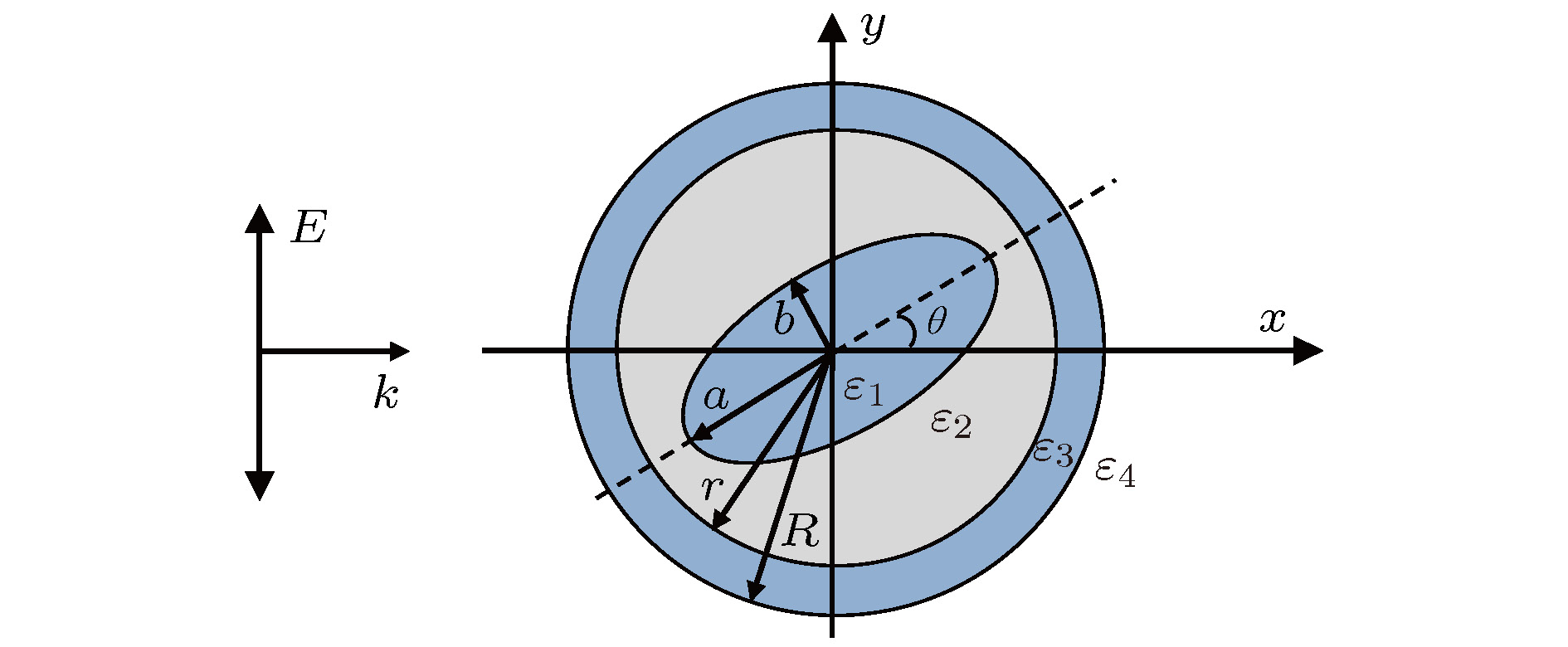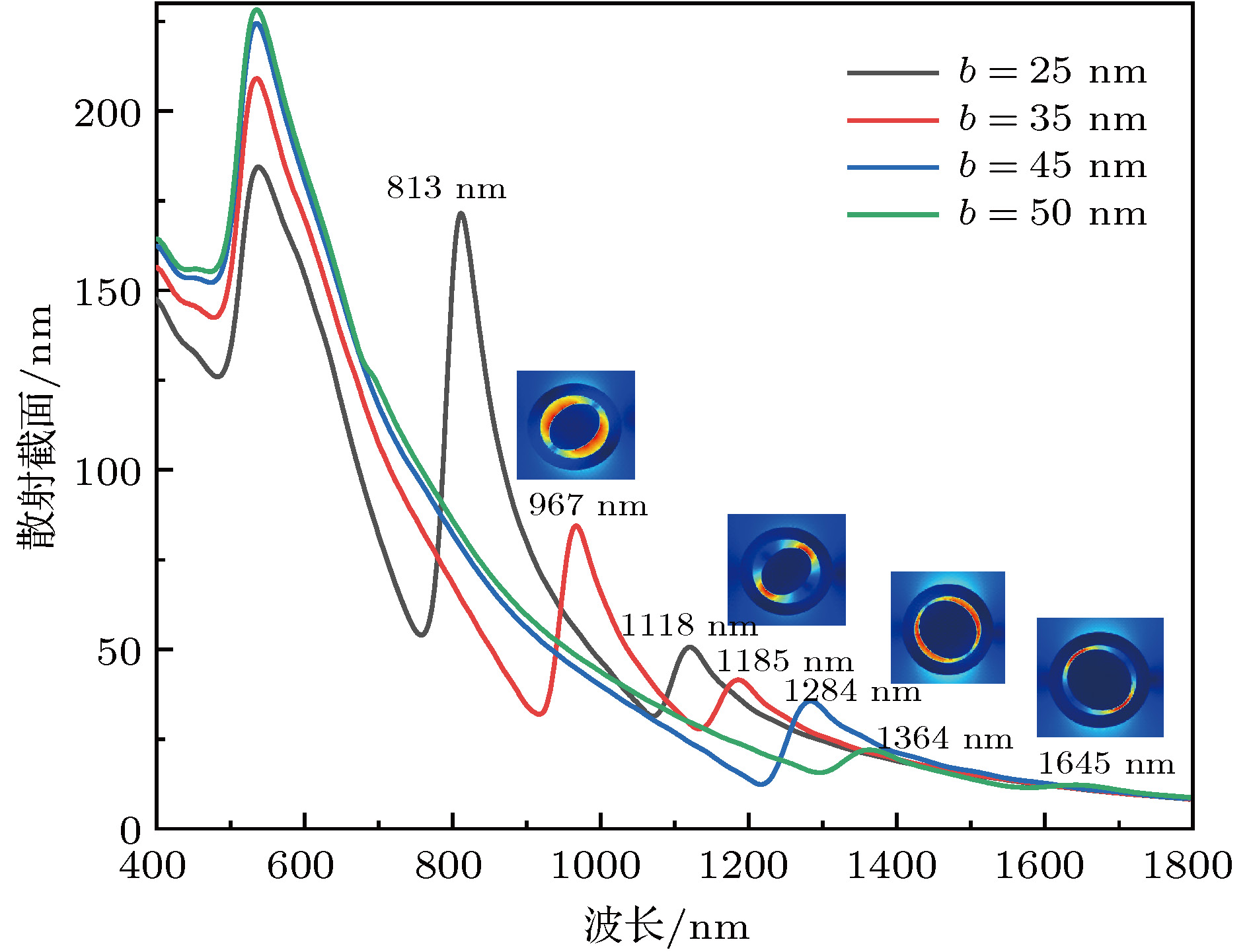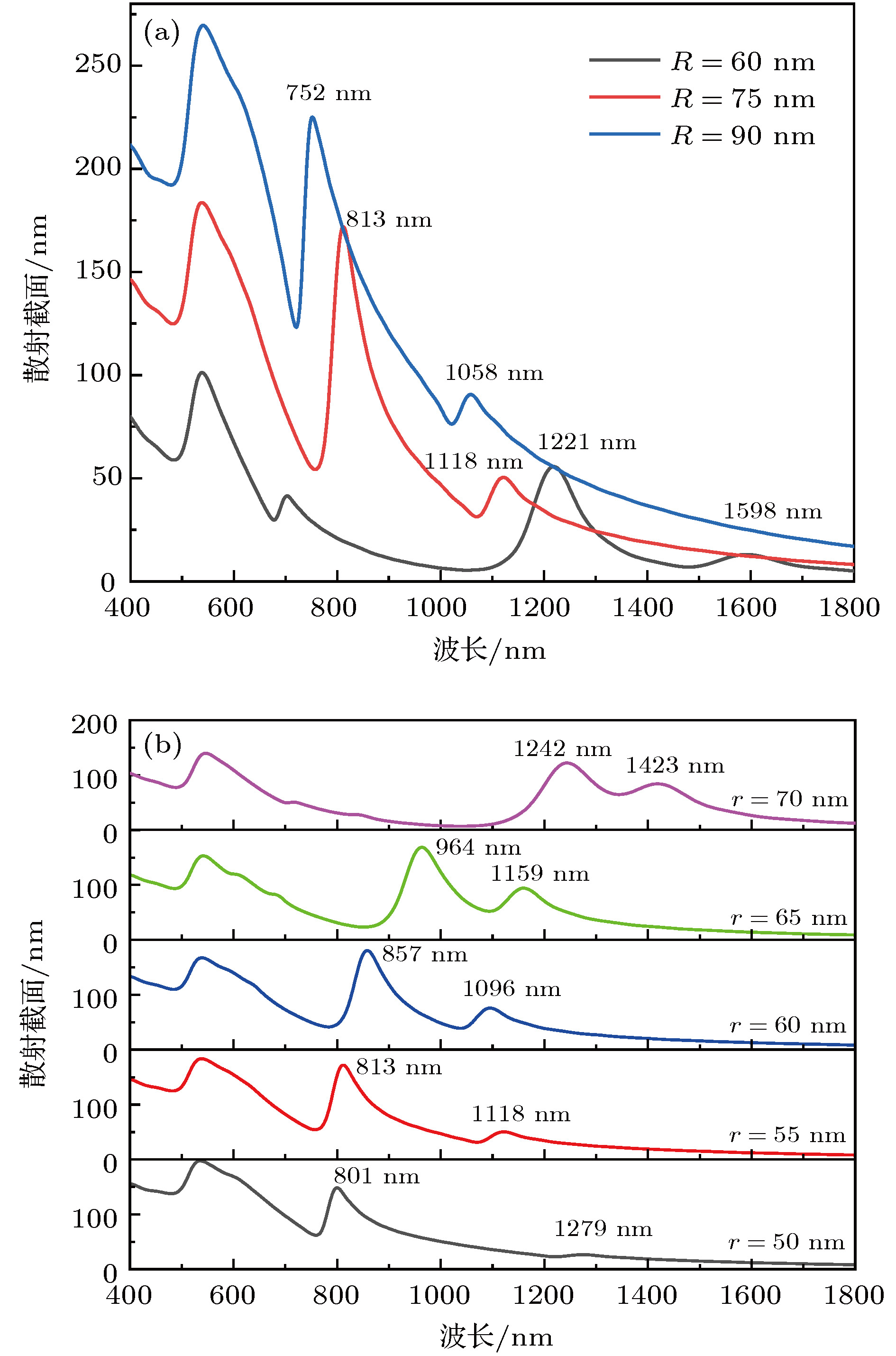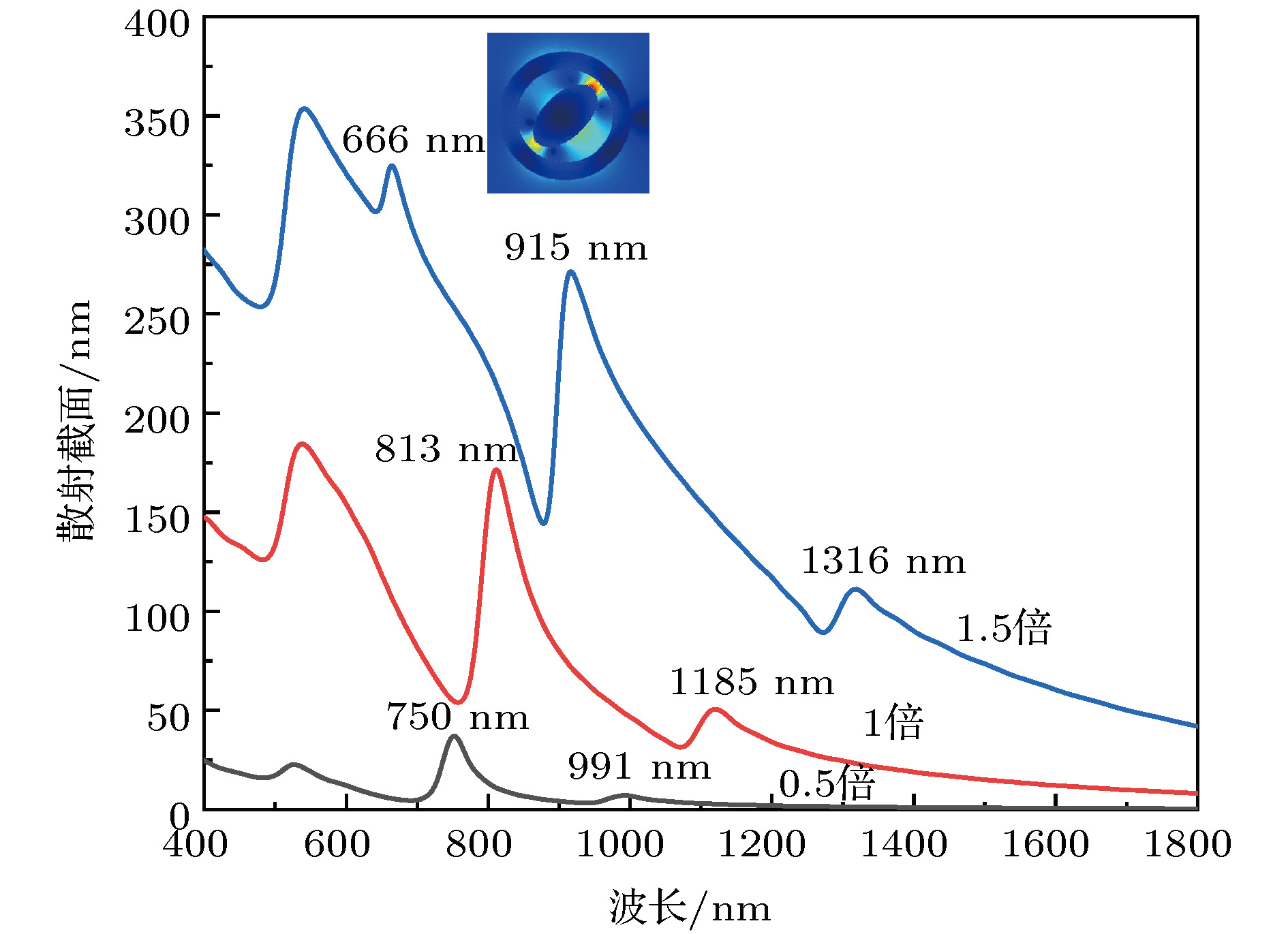-
Optical properties of the concentric composite nanostructure composed of gold nanotube around the center gold elliptical core are investigated based on the finite difference time domain method. According to the simulated absorption and scattering spectra, electric field distributions and charge distributions, we can generate double dipole-dipole Fano resonances by adjusting the angle between the elliptical cylinder core and the linearly polarized excitation light, which is due mainly to the interference between the subradiant dipole mode and the superradiant dipole mode. The narrow, low-energy subradiant mode originates from the symmetric hybrization between the longitudinal or transverse dipole mode of the elliptical cylinder core and the dipole bonding mode of the nanotube, and the broad, high-energy superradiant mode originates from the symmetric hybrization between the core’s dipole mode and the nanotube’s dipole antibonding mode. Moreover, the intensities and spectral positions of the two Fano resonances can be manipulated by modifying the geometric parameters of the composite structure. By increasing the semiminor axis of elliptical core, the high-energy Fano resonance red-shifts faster than the low-energy Fano resonance due to the increase of the interaction coupling between the transverse dipole mode of the core and the dipole mode of the nanotube, and becomes weaker in the scattering spectrum because of the reduced radiation intensity of the superradiant dipole mode. When the semimajor axis is changed, a similar phenomenon occurs in the low-energy Fano resonance. In addition, the two Fano resonances red-shift when outer radius of the nanotube increases, but the shift of low-frequency and high-frequency Fano resonance are inconsistent as the inner radius of the nanotube changes. The high-frequency Fano resonance red-shifts monotonically while the low-frequency Fano resonance first blue-shifts and then red-shifts with the increase of inner radius of nanotube because the red shift of the dipole bonding nanotube mode competes with the spectral shifts induced by the diminishing hybridization between elliptical core and nanotube mode. It can also be concluded that the dipole-dipole Fano resonances become apparent and higher order Fano resonance occurs when the composite nanostructure is scaled to a larger size due to the increased radiative damping. With the core and nanotube size fixed, Fano resonance is insensitive to the change of the external environment, but has a good response to the nuclear material of the nanotube.
-
Keywords:
- surface plasmon polariton /
- Fano resonance /
- nanotube /
- finite difference time domain
[1] Liang H Y, Wei H, Xu H X 2016 Front. Phys. 11 117301
 Google Scholar
Google Scholar
[2] Chen W, Hu H, Jiang W, Xu Y, Zhang S, Xu H 2018 Chin. Phys. B 27 107403
 Google Scholar
Google Scholar
[3] Halas N J, Lal S, Chang W S, Nordlander P 2011 Chem. Rev. 111 3913
 Google Scholar
Google Scholar
[4] Hao F, Nordlander P, Sonnefraud Y, Dorpe P V, Maier S A 2009 ACS Nano 3 643
 Google Scholar
Google Scholar
[5] Li J, Liu T, Zheng H, Dong J, He E, Gao W, Han Q, Wang C, Wu Y 2014 Plasmonics 9 1439
 Google Scholar
Google Scholar
[6] Sonnefraud Y, Verellen N, Sobhani H, Vandenbosch G A E, Dorpe P, Nordlander P, Moshchalkov V V, Maier S A 2010 ACS Nano 4 1664
 Google Scholar
Google Scholar
[7] Sanchoparramon J, Jelovina D 2014 Nanoscale 6 13555
 Google Scholar
Google Scholar
[8] Ho J F, Boris L, Zhang J B 2012 Appl. Phys. A 107 133
 Google Scholar
Google Scholar
[9] Pena-Rodriguez O, Rivera A, Campoy-Quiles M, Pal U 2012 Nanoscale 5 209
[10] Zhou H, Gao D, Gao L 2018 Plasmonics 13 623
 Google Scholar
Google Scholar
[11] Shao L, Fang C, Chen H, Man Y C, Wang J, Lin H Q 2012 Nano Lett. 12 1424
 Google Scholar
Google Scholar
[12] Li J, Gu Y, Gong Q 2010 Opt. Express 18 17684
 Google Scholar
Google Scholar
[13] Ci X, Wu B, Song M, Liu Y, Chen G, Wu E, Zeng H 2014 Appl. Phys. A 117 955
 Google Scholar
Google Scholar
[14] Yang Z J, Hao Z H, Lin H Q, Wang Q Q 2014 Nanoscale 6 4985
 Google Scholar
Google Scholar
[15] Cui Y, Zhou J, Tamma V A, Park W 2012 ACS Nano 6 2385
 Google Scholar
Google Scholar
[16] Fang Z, Cai J, Yan Z, Nordlander P, Halas N J, Zhu X 2011 Nano Lett. 11 4475
 Google Scholar
Google Scholar
[17] Zhang S, Bao K, Halas N J, Xu H, Nordlander P 2011 Nano Lett. 11 1657
 Google Scholar
Google Scholar
[18] Velichko E A, Nosich A I 2013 Opt. Lett. 38 4978
 Google Scholar
Google Scholar
[19] Yu H Q, Jiang S M, Wu D J 2015 J. Appl. Phys. 117 153101
 Google Scholar
Google Scholar
[20] 丛超, 吴大建, 刘晓峻 2011 物理学报 60 046102
 Google Scholar
Google Scholar
Cong C, Wu D J, Liu X J 2011 Acta Phys. Sin. 60 046102
 Google Scholar
Google Scholar
[21] Xu H, Li H, Liu Z, Xie S, Fu S, Zhou X 2012 Opt. Commun. 285 3202
 Google Scholar
Google Scholar
[22] Zhu J, Li J J, Zhao J W 2013 J. Phys. Chem. C 117 584
 Google Scholar
Google Scholar
[23] Zhang J, Zayats A 2013 Opt. Express 21 8426
 Google Scholar
Google Scholar
[24] Wu D J, Yu H Q, Jiang S M, Wu X W, Liu X J 2014 Sci. China 57 1063
 Google Scholar
Google Scholar
[25] Wu D, Jiang S, Cheng Y 2012 Opt. Express 20 26559
 Google Scholar
Google Scholar
[26] Chen H L, Gao L 2013 Opt. Express 21 23619
 Google Scholar
Google Scholar
[27] Gao D, Gao L, Novitsky A, Novitsky A, Chen H, Boris L 2015 Opt. Lett. 40 4162
 Google Scholar
Google Scholar
[28] Taflove A, Hagness S 2000 Computational Electrodynamics: the Finite-Difference Time-Domain Method (Vol.2)(Boston: Artech House) pp75−85
[29] Johnson P B, Christy R W 1972 Phys. Rev. B 6 4370
 Google Scholar
Google Scholar
[30] Mukherjee S, Sobhani H, Lassiter J B, Bardhan R, Nordlander P, Halas N J 2010 Nano Lett. 10 2694
 Google Scholar
Google Scholar
[31] 潘庭婷, 曹文, 邓彩松, 王鸣, 夏巍, 郝辉 2018 物理学报 67 157301
 Google Scholar
Google Scholar
Pan T T, Cao W, Deng C S, Wang M, Xia W, Hao H 2018 Acta Phys. Sin. 67 157301
 Google Scholar
Google Scholar
-
图 3 金纳米管复合结构的等离激元共振杂化示意图 (a) SiO2核-金壳; (b)复合结构; (c)金椭圆柱分别在θ = 0°和90°时的散射光谱; 插图为共振时各个结构的电荷分布图
Figure 3. Plasmon hybridization in a nanotube composite structure. Scattering spectra for (a) SiO2-core Au-shell nanotube in vacuum, (b) composite structure and (c) Au elliptical cylinder embedded in SiO2. Inset shows the surface charge distributions at the corresponding resonance energies.
图 4 复合结构的散射谱随椭圆芯长轴的变化(内插图为复合结构在峰值波长的电场分布)
Figure 4. Scattering spectra of nanotube composite structure as a function of the semimajor axis a. Inset shows electric field distributions corresponding to each peak in the scattering spectra, the numbers in white indicate the maximum electric field enhancements.
-
[1] Liang H Y, Wei H, Xu H X 2016 Front. Phys. 11 117301
 Google Scholar
Google Scholar
[2] Chen W, Hu H, Jiang W, Xu Y, Zhang S, Xu H 2018 Chin. Phys. B 27 107403
 Google Scholar
Google Scholar
[3] Halas N J, Lal S, Chang W S, Nordlander P 2011 Chem. Rev. 111 3913
 Google Scholar
Google Scholar
[4] Hao F, Nordlander P, Sonnefraud Y, Dorpe P V, Maier S A 2009 ACS Nano 3 643
 Google Scholar
Google Scholar
[5] Li J, Liu T, Zheng H, Dong J, He E, Gao W, Han Q, Wang C, Wu Y 2014 Plasmonics 9 1439
 Google Scholar
Google Scholar
[6] Sonnefraud Y, Verellen N, Sobhani H, Vandenbosch G A E, Dorpe P, Nordlander P, Moshchalkov V V, Maier S A 2010 ACS Nano 4 1664
 Google Scholar
Google Scholar
[7] Sanchoparramon J, Jelovina D 2014 Nanoscale 6 13555
 Google Scholar
Google Scholar
[8] Ho J F, Boris L, Zhang J B 2012 Appl. Phys. A 107 133
 Google Scholar
Google Scholar
[9] Pena-Rodriguez O, Rivera A, Campoy-Quiles M, Pal U 2012 Nanoscale 5 209
[10] Zhou H, Gao D, Gao L 2018 Plasmonics 13 623
 Google Scholar
Google Scholar
[11] Shao L, Fang C, Chen H, Man Y C, Wang J, Lin H Q 2012 Nano Lett. 12 1424
 Google Scholar
Google Scholar
[12] Li J, Gu Y, Gong Q 2010 Opt. Express 18 17684
 Google Scholar
Google Scholar
[13] Ci X, Wu B, Song M, Liu Y, Chen G, Wu E, Zeng H 2014 Appl. Phys. A 117 955
 Google Scholar
Google Scholar
[14] Yang Z J, Hao Z H, Lin H Q, Wang Q Q 2014 Nanoscale 6 4985
 Google Scholar
Google Scholar
[15] Cui Y, Zhou J, Tamma V A, Park W 2012 ACS Nano 6 2385
 Google Scholar
Google Scholar
[16] Fang Z, Cai J, Yan Z, Nordlander P, Halas N J, Zhu X 2011 Nano Lett. 11 4475
 Google Scholar
Google Scholar
[17] Zhang S, Bao K, Halas N J, Xu H, Nordlander P 2011 Nano Lett. 11 1657
 Google Scholar
Google Scholar
[18] Velichko E A, Nosich A I 2013 Opt. Lett. 38 4978
 Google Scholar
Google Scholar
[19] Yu H Q, Jiang S M, Wu D J 2015 J. Appl. Phys. 117 153101
 Google Scholar
Google Scholar
[20] 丛超, 吴大建, 刘晓峻 2011 物理学报 60 046102
 Google Scholar
Google Scholar
Cong C, Wu D J, Liu X J 2011 Acta Phys. Sin. 60 046102
 Google Scholar
Google Scholar
[21] Xu H, Li H, Liu Z, Xie S, Fu S, Zhou X 2012 Opt. Commun. 285 3202
 Google Scholar
Google Scholar
[22] Zhu J, Li J J, Zhao J W 2013 J. Phys. Chem. C 117 584
 Google Scholar
Google Scholar
[23] Zhang J, Zayats A 2013 Opt. Express 21 8426
 Google Scholar
Google Scholar
[24] Wu D J, Yu H Q, Jiang S M, Wu X W, Liu X J 2014 Sci. China 57 1063
 Google Scholar
Google Scholar
[25] Wu D, Jiang S, Cheng Y 2012 Opt. Express 20 26559
 Google Scholar
Google Scholar
[26] Chen H L, Gao L 2013 Opt. Express 21 23619
 Google Scholar
Google Scholar
[27] Gao D, Gao L, Novitsky A, Novitsky A, Chen H, Boris L 2015 Opt. Lett. 40 4162
 Google Scholar
Google Scholar
[28] Taflove A, Hagness S 2000 Computational Electrodynamics: the Finite-Difference Time-Domain Method (Vol.2)(Boston: Artech House) pp75−85
[29] Johnson P B, Christy R W 1972 Phys. Rev. B 6 4370
 Google Scholar
Google Scholar
[30] Mukherjee S, Sobhani H, Lassiter J B, Bardhan R, Nordlander P, Halas N J 2010 Nano Lett. 10 2694
 Google Scholar
Google Scholar
[31] 潘庭婷, 曹文, 邓彩松, 王鸣, 夏巍, 郝辉 2018 物理学报 67 157301
 Google Scholar
Google Scholar
Pan T T, Cao W, Deng C S, Wang M, Xia W, Hao H 2018 Acta Phys. Sin. 67 157301
 Google Scholar
Google Scholar
Catalog
Metrics
- Abstract views: 12024
- PDF Downloads: 70
- Cited By: 0















 DownLoad:
DownLoad:











